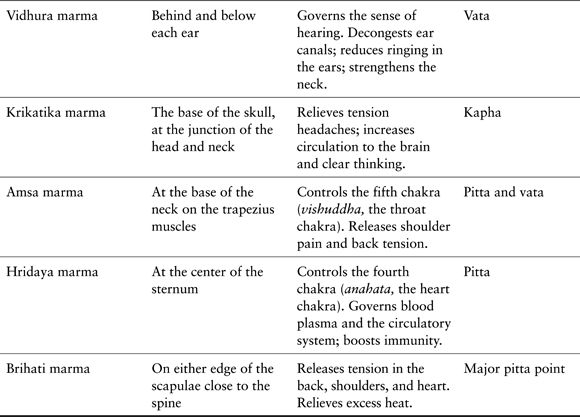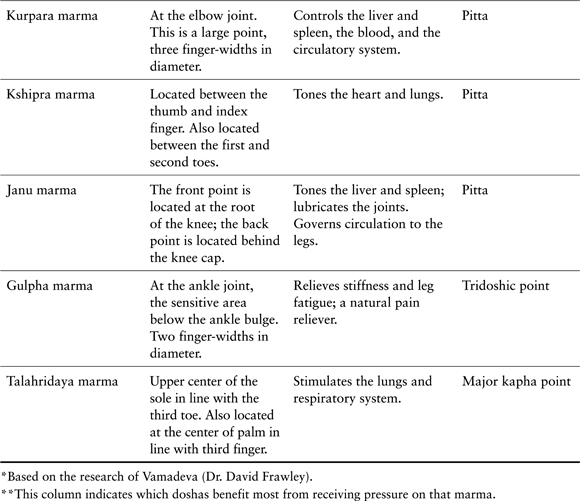
Working the Sen Lines and Marma Points
According to Ayurveda, there are 107 vital energy points, or marmas, that exist throughout the human body. These points are important hubs of pranic energy that can be stimulated to increase energy flow, remove blockages, or even tap into hidden energy reserves.
The translation of the Sanskrit word marma is “secret” or “hidden.” Such mysterious undertones to marma theory can be traced to the original application of the science of the marmas within the Indian martial art form known as kalari payat. Marma points are broadly classified as either lethal for injuring the enemy or therapeutic for protecting oneself. According to the kalari payat tradition, there are twelve marma points that can cause sudden death.
Traditionally, the exact location of the lethal and therapeutic points has been considered a sacred and protected knowledge; as such, it has been passed orally across the generations from teacher to student. In many parts of Kerala in southern India this ancient tradition is still honored, as kalari payat masters will only teach the exact location of marma points to their most senior students.
Acquiring in-depth knowledge of the marmas requires many years of hard work and one-on-one study with a reputed master. However, an introductory knowledge of some key marma points provides an insight to the profound therapeutic value of this system.
As with the acupuncture points in traditional Chinese medicine, each marma point relates to specific organs or tissues within the body. Marma points are thus identified with one or more of the tridoshas, in correspondence with the sites at which stagnant energy tends to collect for each dosha. (See the discussion of accumulation sites in chapter 3.) For example, when working on kaphas, who tend to accumulate stagnant energy in the lungs, one might stimulate the Talahridaya lung marma point at the center of their feet and palms.
The eighteen marmas selected for the Thai Yoga Massage form taught in this book are considered by most masters to be major points by virtue of their strong therapeutic values. Because of their size and location, these points are also among the easiest to work on within a Thai Yoga Massage format. The exact location of each marma and its therapeutic qualities have been identified following the research of Vamadeva (Dr. David Frawley) and the books of Swami Sada Shiva Tirtha and Ayurvedic medical doctor Hans. H. Rhyner. Seven of the marma points presented here directly correspond to the seven chakras, the vital energy centers aligned along the spinal column. By stimulating these points during a massage session we are effectively releasing a flow of energy throughout the entire chakra system.
The position, healing attributes, and doshic applications of each marma point are detailed in the table on pages 70 and 71. We have also included a drawing of the eighteen marma points used in this massage for ease in locating them.
Marmas are most easily stimulated by pressure applied with the thumb, the main pranic channel in the hand. However, the index finger, knuckle, heel of the hand, elbows, arms, knees, and feet can also be used with many of the marma points. In alignment with the three main massage approaches, the amount of recommended pressure varies according to the doshic needs of your recipient—gentle for vatas, moderate for pittas, and deep for kaphas. For localized marma pressure therapy at the end of the massage, you may wish to apply a small amount of the base oil that corresponds to the recipient’s dosha, and add a few drops of essential oil. (For appropriate base oils see the table Massage Approach for Each Body Type on page 27.) Mahanarayan oil is a classic Ayurvedic blend of up to several dozen herbs that is suitable for all three doshas. This therapeutic oil has been used for centuries in India to relieve muscle and joint pain and can now be found in many Ayurvedic supply centers in the West.
All oils should be applied in the direction of hair growth and should be left on the marma point until the recipient’s next shower.
Before beginning to apply marma pressure, bring your full awareness to the therapeutic properties and location of the specific marma point you will be working on. Apply gentle pressure with your thumb and gradually pour in with your body weight.


Apply pressure for approximately 5 to 10 seconds for general upkeep, or for up to one minute for deeper therapy. In order to prevent injury or discomfort, make sure to use the pad of the thumb. Direct pressure or circular motion can be applied, followed by a gentle massage of the region.
Clockwise motion is strengthening and helps to revitalize a marma point while counterclockwise movement helps to remove blockage and stagnation. But when considering clockwise or counterclockwise movement, don’t overanalyze your work!
As you work on the marmas, visualize each point as an essential transfer station that passes vital energy throughout the region. Encourage the free and peaceful flow of energy through each transfer point. Direct your own breathing to the marma point, inhaling positive healing energy and exhaling negativity and tension. You may also direct your recipient to breathe into a marma point that seems particularly tender or stagnant.
When experiencing marma pressure your client may feel a range of sensations—a delicious sense of release, a stimulation of energy, or a sense of lightness directly following the removal of pressure. If your client experiences pain while you are working on a particular marma, there may be a blockage or stagnant energy occurring at that point. In such cases, only work as deeply as your client is comfortable and do not cause excessive discomfort.
Never work on the marma points on a client who is pregnant, diagnosed with cancer, or suffering from inflammation or a skin disorder. Points on the face, head, and abdomen are more sensitive, so apply less pressure to these areas. Points on the arms, legs, feet, and hands are easiest to work on and can be very powerful in their effects.
In order to maintain the even distribution of energy, be sure to massage the marma points on both the right and left sides of the body. When working on marmas with multiple locations, such as the kshipra point, located on the hands and feet, make sure to massage both the lower and the upper points to prevent an imbalance of energy.

Proper use of the thumbs is important. Hyperextension (left) can lead to thumb injury. Applying pressure with the tip of the thumb (center) can cause discomfort for the recipient. Use the pad of the thumb (right) when applying pressure to the marma points.
Whether the points are worked during energy-line palpation or are massaged separately at the end of the treatment, there are some general methods for customizing this aspect of the massage according to the doshic needs of each client.
When applying the appropriate massage style for a given dosha, whether it be sattvic, rajasic, or tamasic, the practitioner effectively becomes a conduit of universal energy and embodies the qualities of that guna. Of all the massage techniques a practitioner can apply, the most important is intention. It is important to take the time to willfully connect to the appropriate approach before beginning a session and to maintain that approach throughout the massage.
Embodying a quality or energetic force when giving a massage is a powerful process that must be done with mindful awareness in order to avoid disturbing the practitioner’s own doshic balance. Practitioners can maintain a certain level of neutrality and egolessness by remembering that, in giving a Thai Yoga Massage based on the principles of Ayurveda, we are offering ourselves as vehicles for transmitting sacred wisdom teachings about the body that are both ancient and effective. When we remove interference from the ego, the intuitive energy of the universe can flow through us unimpeded.
Taking the Namaskar position at the beginning and end of each session serves as a reminder to attune ourselves to this universal energy that expands beyond the self. A pleasant-sounding bell or the sound of Om serves to bring closure to a session and to reestablish the physical and energetic separation between practitioner and recipient.
Despite the doshic variances among your clientele, it is recommended that you begin your massage with a sattvic touch to relax the recipient’s body before applying a more rigorous approach.
Customizing sen energy-line work according to a client’s dosha requires adapting your working pace and pressure to provide the recommended rhythm for that dosha. Kaphas require the most rapid pace for sen-line work, with a recommended pause of one second during palming and thumbing. A moderate pace with light pressure and an approximate pause of two seconds during palming and thumbing is most beneficial for pittas. When receiving palming or thumbing along the sen lines, vatas benefit from a slower pace. A three-second pause before the practitioner changes hands would be appropriate for vata recipients, who need to be reminded to slow down and embrace moments of stillness.
Because the approximate time allotted to sen work during a massage should be equivalent for all three doshas, one must adjust the distance and speed of rounds to the chosen pace. This adjustment follows basic common sense, but is good to consider before performing a massage. For example, when doing sen-line work on a vata client the recommended slow vata rhythm can be offset by placing our palms a greater distance away from each other. Kapha types, on the other hand, require a more vigorous pacing which can be offset by less distance between our palms. Again, this will require more thought at the beginning, but should become a natural exercise as your understanding of Ayurveda deepens.
Our journey has so far uncovered several tools for customizing a Thai Yoga Massage session according to the Ayurvedic constitution of our clients. We will now look at how we can direct our breath and the breath of our clients as a final therapeutic component to Thai Yoga Massage.